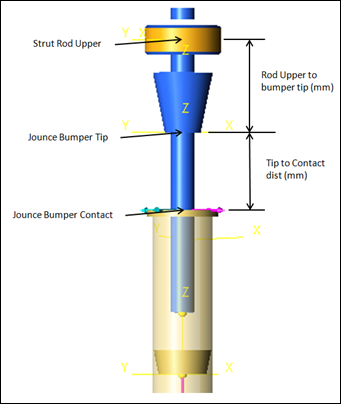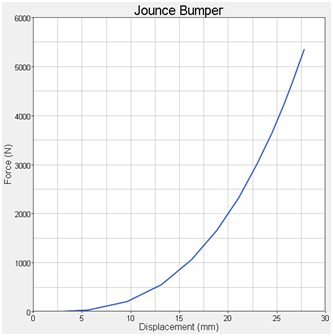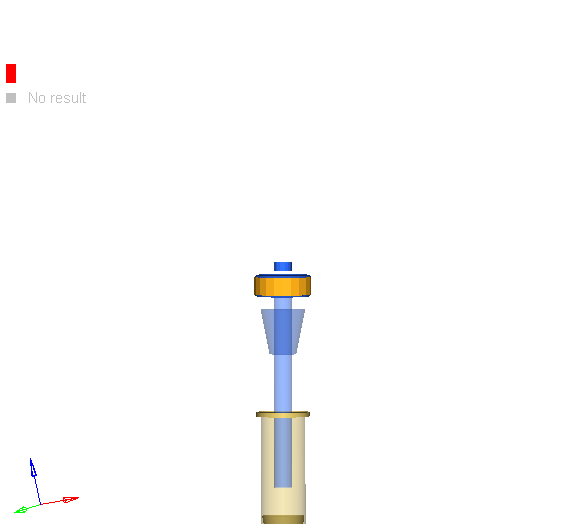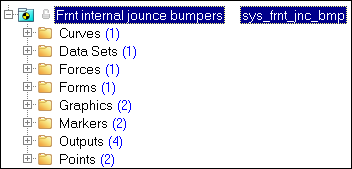Front Internal Jounce Bumper |

|

|

|

|
|
Front Internal Jounce Bumper |

|

|

|

|
The Internal Jounce Bumper system is used to simulate a jounce bumper that is internal to the shock absorber, or strut, on a front or rear suspension. The system creates forces, requests, and graphics of the bumper. The force acts between the strut or shock rod and the strut or shock tube. The bumper is oriented using lengths along the strut/shock instead of XYZ coordinates. The Force-Deflection characteristics of the Jounce bumper are defined by the Curve in the Jounce Bumper system. In models built via the Assembly Wizard, the Jounce Bumper system is a child of the suspension system.

Front Internal Jounce Bumpers with Full Vehicle

Jounce Bumper Points and Distances

Jounce Bumper Force - Deflection Curve

| • | The Force element in the system uses an expression to turn on and off the jounce bumper when the tip reaches the contact. |
| • | Linear extrapolate is on by default in the jounce bumper curve. For robust simulations, make sure the force deflection curve values exceed the forces and deflections seen in the simulation. |
| • | The system uses calculated point locations to define the graphics and force locations. Markers (based on the points) are used in the Force expression. |
| • | The Force deflection curve of the Jounce bumper is 0,0 when the bumper just touches the contact point, and is a positive pair of points after contact. |
| • | The graphics are defined so the Jounce bumper graphic (represented by the cone) begins to pass through the contact plane graphic (a flat round plate) at the same time the jounce bumper force initiates. |
| • | The jounce bumper force acts at the “contact point” and is an action/reaction force which acts along the axis of the strut, or shock, between the strut/shock rod and the strut/shock tube bodies. |
| • | Damping is ignored, however it is able to be added. |
The entities in the analysis are displayed in the MotionView Project Browser as shown in the image below:

Project Browser View - Front Internal Jounce Bumper
Attachments determine how the system connects to the rest of the model. The Front Internal Jounce Bumper system includes four attachments (Rod Body, Tube Body, Upper Rod, and Lower Tube).
Front Internal Jounce Bumpers - Attachments
|
The Front Internal Jounce Bumper system contains one option: Compliant. Setting this option to No will have no affect on the internal jounce bumper system entities.
Front Internal Jounce Bumpers - Options |
A single curve is included in the system (Jounce Bumper 1). The curve defines the Force-displacement behavior of the jounce bumper. The 0,0 point on the curve is when the bumper initially contacts the contact surface. Data should always be in the positive quadrant and should always increase in both the X and Y directions.
Project Browser View - Curves - Jounce Bumper 1
Curve Panel - Jounce Bumper 1
Preview Window Dialog - Jounce Bumper 1 |
One dataset (Jounce Bumper Lengths) is used in the system and contains dimensions that define the Jounce Bumper system. Two lengths define the graphics and forces of the jounce bumper. The Shock length is a calculated value.
Project Browser View - Datasets - Jounce Bumpers Lengths
Dataset Property Dialog - Datasets - Jounce Bumper Lengths
Datasets - Jounce Bumpers Lengths |
The Front Internal Jounce Bumper contains one force (Jounce Bumper). This is an action-reaction force that acts in the translational direction, between the Strut Tube and Strut Rod along the axis of the strut or shock absorber. The translational force properties are non-linear and are defined using a curve.
Project Browser View - Forces - Jounce Bumper
Jounce Bumper Panel
Principal Forces - Front Internal Jounce Bumper |
One Form is used in the Front Internal Jounce Bumper system (Jounce Bumper Lengths). The Form is the only place where changes should be made to the Jounce Bumper length data. The two parameters that can be changed are: Rod upper to Bumper tip and Tip to contact distance.
Project Browser View - Forms - Jounce Bumpers Lengths
Jounce Bumper Lengths Dialog
Forms - Jounce Bumpers Lengths |
Two Graphics are used in Front Internal Jounce Bumper (Jounce Bumper and Jounce Bumper Contact). The Jounce Bumper attaches to the Strut Rod (upper strut) and the Jounce Bumper Contact attaches to the Strut Tube (lower strut).
Project Browser View - Graphics - Front Internal Jounce Bumper
Jounce Bumper and Jounce Bumper Contact Graphics |
Two Markers that are symmetrical about XZ plane are used in the Front Internal Jounce Bumper system (Force Direction Reference and Displacement Reference).
Project Browser View - Markers - Front Internal Jounce Bumpers The force direction reference marker is located on the strut tube and the displacement reference marker is located on the strut rod. These markers are used define the location and direction for the Forces and Requests in the Jounce Bumper system.
Markers - Front Internal Jounce Bumper |
|---|
Four output requests are used in Front Internal Jounce Bumper system (Left Jounce Bumper Displacement, Right Jounce Bumper Displacement, Left Jounce Bumper Force, and Right Jounce Bumper Force). These four requests will generate eight sets of results.
Project Browser View - Outputs - Front Internal Jounce Bumpers
An example of the jounce bumper displacement output is shown below:
An example plot of the jounce bumper Force output plot is shown below:
|
Two point pairs are used in the Front Internal Jounce Bumper system. These points are used to create the Jounce Bumper Tip and the Jounce Bumper Contact. The points contain parametric logic to define their X, Y, and Z locations. No user modification of any points should be necessary.
Project Browser View - Points - Front Internal Jounce Bumpers
Jounce Bumper Points and Dimensions The table below shows the coordinate values for the Jounce Bumper Tip point when located internally:
The variables used in the above expression are described below:
The table below shows the co-ordinate values for the Jounce Bumper Contact point when located internally:
The variables used in the above expression are described below:
|
|---|
| • | Rear Internal Jounce Bumpers |
| • | Front Internal Rebound Bumpers |
| • | Rear Internal Rebound Bumpers |